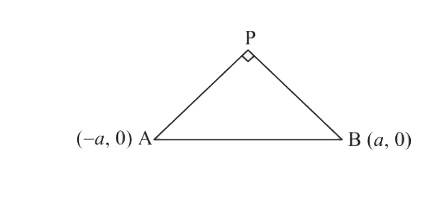A & B are two fixed points. The vertex C of △ABC moves such that cotA+cotB= constant. The locus of C is a straight line
To solve the problem, we need to analyze the given condition that cot A + cot B = constant, where A and B are fixed points, and C is a variable point.
1. Understanding Cotangent in Triangle:
- In triangle ABC, we know that:
cotA=ADCDandcotB=DBCD
- Here, D is the foot of the perpendicular from C to line AB.
2. Adding Cotangents:
- We can express the sum of cotangents as follows:
cotA+cotB=ADCD+DBCD=AD+DBCD
- Since AD + DB = AB (the entire length of line segment AB), we can rewrite the equation:
cotA+cotB=ABCD
3. Setting the Constant:
- According to the problem, we have:
cotA+cotB=k(where k is a constant)
- Therefore, we can equate this to our previous expression:
ABCD=k
4. Rearranging the Equation:
- Rearranging gives us:
CD=ABk
- Since AB is a constant (as A and B are fixed points), we conclude that CD must also be a constant.
5. Locus of Point C:
- Since CD is constant, the distance from point C to line AB (which is the perpendicular distance) remains constant as C moves.
- This indicates that point C traces out a line that is parallel to line AB.
Conclusion:
The locus of point C, as it moves such that cot A + cot B remains constant, is a straight line parallel to line segment AB.
- In triangle ABC, we know that:
cotA=ADCDandcotB=DBCD
- Here, D is the foot of the perpendicular from C to line AB.
- We can express the sum of cotangents as follows:
cotA+cotB=ADCD+DBCD=AD+DBCD
- Since AD + DB = AB (the entire length of line segment AB), we can rewrite the equation:
cotA+cotB=ABCD
- According to the problem, we have:
cotA+cotB=k(where k is a constant)
- Therefore, we can equate this to our previous expression:
ABCD=k
- Rearranging gives us:
CD=ABk
- Since AB is a constant (as A and B are fixed points), we conclude that CD must also be a constant.
- Since CD is constant, the distance from point C to line AB (which is the perpendicular distance) remains constant as C moves.
- This indicates that point C traces out a line that is parallel to line AB.
The locus of point C, as it moves such that cot A + cot B remains constant, is a straight line parallel to line segment AB.
Similar Questions
A and B are fixed points such that AB=2a. The vertex C of ΔABC such that cotA+cotB=constant. Then locus of C is
View SolutionA and B are two fixed points. The locus of a point P such that ∠APB is a right angle, is:

View SolutionIf the vector product of a constant vector →OA with a variable vector →OB in a fixed plane OAB be a constant vector, then the locus of B is a. a straight line perpendicular to →OA b. a circle with centre O and radius equal to ∣∣→OA∣∣ c. a straight line parallel to →OA d. none of these
View SolutionIf the vector product of a constant vector →OA with a variable vector →OB in a fixed plane OAB be a constant vector, then the locus of B is (a).a straight line perpendicular to →OA (b). a circle with centre O and radius equal to ∣∣→OA∣∣ (c). a straight line parallel to →OA (d). none of these
View SolutionHaving given the bases and the sum of the areas of a number of triangles which have a common vertex, show that the locus of the vertex is a straight line.
View SolutionBase BC of triangle ABC is fixed and opposite vertex A moves in such a way that tan.B2tan.C2 is constant. Prove that locus of vertex A is ellipse.
View SolutionIf a ΔABC remains always similar to a given triangle and the point A is fixed and the point B always moves on a given straight line, then locus of C is (A) a circle (B) a straight line (C) a parabola (D) none of these
View SolutionGiven two points A and B. If area of triangle ABC is constant then locus of point C in space is
View SolutionA straight line is drawn from a fixed point O meeting a fixed straight line in P. A point Q is taken on the line OP such that OP.OQ is constant. Show that the locus of Q is a circle.
View SolutionA straight lien is drawn from a fixed point O metting a fixed straight line P. A point Q is taken on the line OP such that OP.OQ is constant. Show that the locus of Q is a circle.
View Solution
